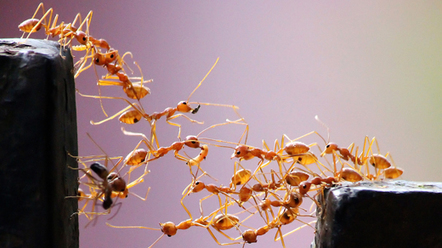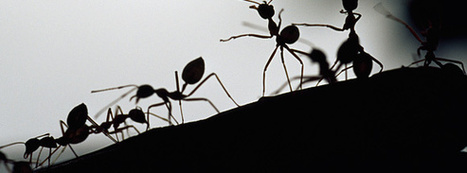 Your new post is loading...
 Your new post is loading...
"Army ants form colonies of millions yet have no permanent home. They march through the jungle each night in search of new foraging ground. Along the way they perform logistical feats that would make a four-star general proud, including building bridges with their own bodies. Much like the swarms of cheap, dumb robots that I explored in my recent article, army ants manage this coordination with no leader and with minimal cognitive resources."
Life is network based. Millions of years of evolution have allowed the natural world to develop what can be argued to be the most tried, tested and optimized protocols in existence: biological networks. The ability for Internet of Things (IoT) market stakeholders to interpret and effectively apply principles derived from the study of biological networks will lead to increased asset and resource productivity, as well as greater system resilience.
Scores of people take expensive management training to learn how to guide colleagues toward a common goal, but maybe they could get less costly lessons by watching how certain fish take the lead in their schools. After training about 90 golden shiners (Notemigonus crysoleucas, seen above) to find a dish of fish food, scientists tagged these potential leaders, released them back in the tank individually with eight untrained fish, and then waited to see what would happen. In some cases, a veteran fish swam around as if it had never been in the tank before, leaving its schoolmates equally confused. Others made a beeline for the soggy fare and were more likely to reach it, but in their haste failed to communicate with fellow fish and left them in their wake. Most of the trained shiners, however, were effective leaders; just assertive enough to indicate which direction the school should travel but not so assertive that they lost the group and the protection it provided, the scientists report online before print in The American Naturalist. The study is the first to show experimentally that such a tradeoff—between achieving a goal as quickly as possible and keeping followers—exists in animals other than humans, possibly revealing some fundamental component of good leadership, the researchers say. So, the next time you need to get your colleagues to meet a deadline, why not give channeling your inner golden shiner a try?
"The German automation giant unleashes a swarm of new robotic insects. [...] The theme of Festo’s “Bionic Learning Network” program this year is “Join the Network,” and their flagship projects are both based around swarms of small robots that mimic the way insects work together and interact with each other."
"Michael Papay, chief executive at Bay Area startup Waggl, said his app is inspired by (and named after) the decision making dance that honeybees have used for millions of years.”
"Insects don’t have the capacity to reason, and yet some are capable of building complex structures and executing complex foraging expeditions with no central organizing. That’s why researchers recently sent ants to the International Space Station and will observe how the change in gravity affects the ants’ ability to organize. At Harvard, scientists are taking their inspiration from termites, which can spend generations building mounds that stretch multiple feet into the air. On Thursday, a research team revealed a crew of iPad-sized robots that can build structures with no input from a central leader."
"Consider the common ant. Each one is by genetic design capable of only a few simple behaviors and binary choices, making it a pretty dumb, rigid, inflexible being. Yet the collective behavior of an ant colony is adaptive, flexible and even creative; it’s a highly structured social organization. Now consider your average human. Most of us are individually adaptive, flexible and very creative. Yet the large organizations in which we work are often inflexible and incapable of adaptation and true innovation. Why are ant colonies so much better than the sum of their parts, while governments and companies are so often much worse?"
"Researchers in the Sheffield Centre for Robotics, jointly established by the University of Sheffield and Sheffield Hallam University, have been working to program a group of 40 robots, and say the ability to control robot swarms could prove hugely beneficial in a range of contexts, from military to medical."
A small fleet of unmanned aerial vehicles was successfully controlled by a US warfighter supplemented with a military radio and a laptop. Earlier in 2012, flight trials were carried out in Oregon, during which a single source directed the Boeing ScanEagle UAVs. These tests will foster hovering of UAVs swarms over the battlefield in future, through which relevant tactical data can be acquired more rapidly and efficiently.
"At the Fraunhofer Institute for Material Flow and Logistics IML in Dortmund, Germany, researchers are working to harness swarm intelligence as a means of improving the flow of materials and goods in the warehouse environment."
|
"Researchers from the University of Granada (UGR) have designed an algorithm, inspired by the intelligent and social behavior of bee colonies, which allows law enforcement to attack and dismantle any type of social network that poses a threat, whether physical or virtual, such as social networks linked to organized crime and jihadist terrorism."
"To optimize its delivery drones, maybe Amazon could take inspiration from the actual Amazon. Army ants in Central and South America aggressively seek out the shortest path over the forest floor to bring home enough food and ensure the future of their colony. This focus on efficiency led the insects to develop a clever trick: They link their bodies together to fill potholes and build living bridges. As more ants join in, the bridges shift locations to span larger and larger gaps, shortening the path ants have to take when carrying food back to the nest. But because each brick in the bridge is also a lost forager, the ants reach a point where a slightly better shortcut just isn’t worth the cost, according to new analysis of this insect construction work."
The European Union CoCoRo research consortium has been developing three varieties of autonomous underwater robots that school together like fish. By doing so, the little bots can share and learn from each others' "knowledge" of their environment, acting as a collective cognitive system.
"When it comes to managing a building’s cooling and heating costs, just look up. It turns out there’s a lot to be learned from the birds and the bees, according to Toronto-based REGEN Energy. The clean tech firm co-ordinates HVAC (heating, ventilating and air-conditioning) systems by tapping into the ability of insect colonies and flocks of birds to display a greater collective intelligence."
"Give a colony of garden ants a week and a pile of dirt, and they'll transform it into an underground edifice about the height of a skyscraper in an ant-scaled city. Without a blueprint or a leader, thousands of insects moving specks of dirt create a complex, spongelike structure with parallel levels connected by a network of tunnels. [...] Knowing the rules behind ant-made structures could help scientists understand how other complex systems emerge in nature."
"In the ongoing drive to create and communicate about sustainability in the emerging economy, it can be useful to conceive of sustainability not as a quantifiable end goal, but as an emergent property. [...] We could learn a thing or two from the collective creatures, the super-organisms, for whom emergence is no big deal —or whom sustainability is given, understood and inevitable."
"Ever notice how ant colonies so successfully explore and exploit resources in the world … to find food at 4th of July picnics, for example? You may find it annoying. But as an ecologist who studies ants and collective behavior, I think it’s intriguing — especially the fact that it’s all done without any central control. What’s especially remarkable: the close parallels between ant colonies’ networks and human-engineered ones. One example is “Anternet”, where we, a group of researchers at Stanford, found that the algorithm desert ants use to regulate foraging is like the Traffic Control Protocol (TCP) used to regulate data traffic on the internet. Both ant and human networks use positive feedback: either from acknowledgements that trigger the transmission of the next data packet, or from food-laden returning foragers that trigger the exit of another outgoing forager."
Thanks to new observation technologies, powerful software, and statistical methods, the mechanics of collectives are being revealed.
Nissan's EPORO robot car prototypes are programmed to think and act like a school of fish to avoid collision.
|
 Your new post is loading...
Your new post is loading...
 Your new post is loading...
Your new post is loading...































